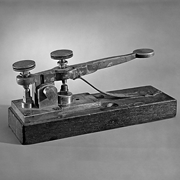E-Archive
Off the Beaten Track
in Vol. 9 - July Issue - Year 2008
The Unfinished Painting

Morse`s first telegraph
“All rise for His Royal Highness!” Almost two hundred chairs shifted simultaneously on the wooden floor as the audience quickly rose to its feet, necks stretching to catch a glimpse as the Sultan made his ceremonial entrance into the large conference hall. The American gentleman rose stiffly, his legs and joints still aching from the long Atlantic crossing, his throat still parched after spending six interminable days in a hot and stuffy cabin on the subsequent voyage from London to Istanbul. But it had all been well worth the effort, for the Sultan himself had personally tested the visitor’s invention and had remained sufficiently impressed to grant the American what he had come to seek. For now, in the presence of so many local dignitaries and ambassadors, Samuel Morse was to receive a patent for his invention of the telegraph.
Samuel Morse was born in Charlestown, Massachusetts on the 27th of April, 1791. Although he gained worldwide fame thanks to his development of the telegraph and of the telegraphic code which carries his name, it is not widely known that he had actually started out as a rather successful painter, earning money with his artistic skills while still at school. At first, he concentrated on landscapes and on episodes related to North American history, as in one of his first important works entitled Landing of the Pilgrims. Morse soon attracted the attention of Washington Allston, a famous American artist of the time, who obtained permission from Samuel’s father to take the young man to Europe in order to perfect his painting technique.
At the age of twenty, Morse set sail for England, where he dedicated all his energies to his overwhelming passion. Within a few months, he was admitted to the Royal Academy and thus had the opportunity of studying some of the greater Renaissance artists, such as Michelangelo and Raphael, whose drawings of the human body fascinated Samuel and encouraged him to master the skills necessary to draw fine anatomical details. He soon produced what is considered his best work, Dying Hercules, followed shortly later by another painting entitled Judgement of Jupiter. Both pieces were seen by many observers as a way of entering the political and religious debates which were raging between England and the U.S. in that period, during which the two countries actually went to war in 1812.
Morse returned to the States in 1815 and soon established himself as an excellent painter of portraits, adding a couple of U.S. presidents, judges of the Supreme Court and several scions of wealthy and prominent families to his list of works. He also painted the portrait of the French Marquis de Lafayette, one of the heroes of the American Revolution and with whom Morse would develop a lasting friendship.
In 1830, Morse went back to Europe, where he stayed for three years, this time travelling the Continent and visiting numerous art galleries and museums in Italy, Switzerland and France. It was during one of his numerous visits in Paris that he started to paint miniature copies of thirty-eight of the most famous paintings at the Louvre on a single, large canvas measuring two by three meters. His idea was to earn money back home by exhibiting this work, which he planned to entitle The Gallery of the Louvre.
How did all this lead Samuel Morse to the telegraph? On the ship taking him back to the States, he met an American from Boston who got him interested in electromagnetism and who inspired him to begin experimenting with this relatively new science. Samuel improved on previous designs by British and American inventors and came up with an electric telegraph which proved practical and which he felt had enormous commercial potential. Although he obtained a U.S. patent in 1837, initially Morse failed to generate enough interest among the American public and government and he was forced to go to Europe to look for financial backing and for more patents. Finding that other inventors had preceded him in England, Morse continued his quest through several countries on the Continent, where he received a warm welcome at the court of the Sultan of the Ottoman Empire in 1847.
During this period, in which Morse alternated trips to Europe and to Washington D.C., things finally started going his way and Morse succeeded in founding his first telegraph company in New York.
As to The Gallery of the Louvre, the painting gathered dust in a corner of Samuel’s bedroom, never to be completed.
By Giovanni Gregorat, Contributing Editor MFN
& Sales Manager, Pometon Abrasives
Author: Giovanni Gregorat



























